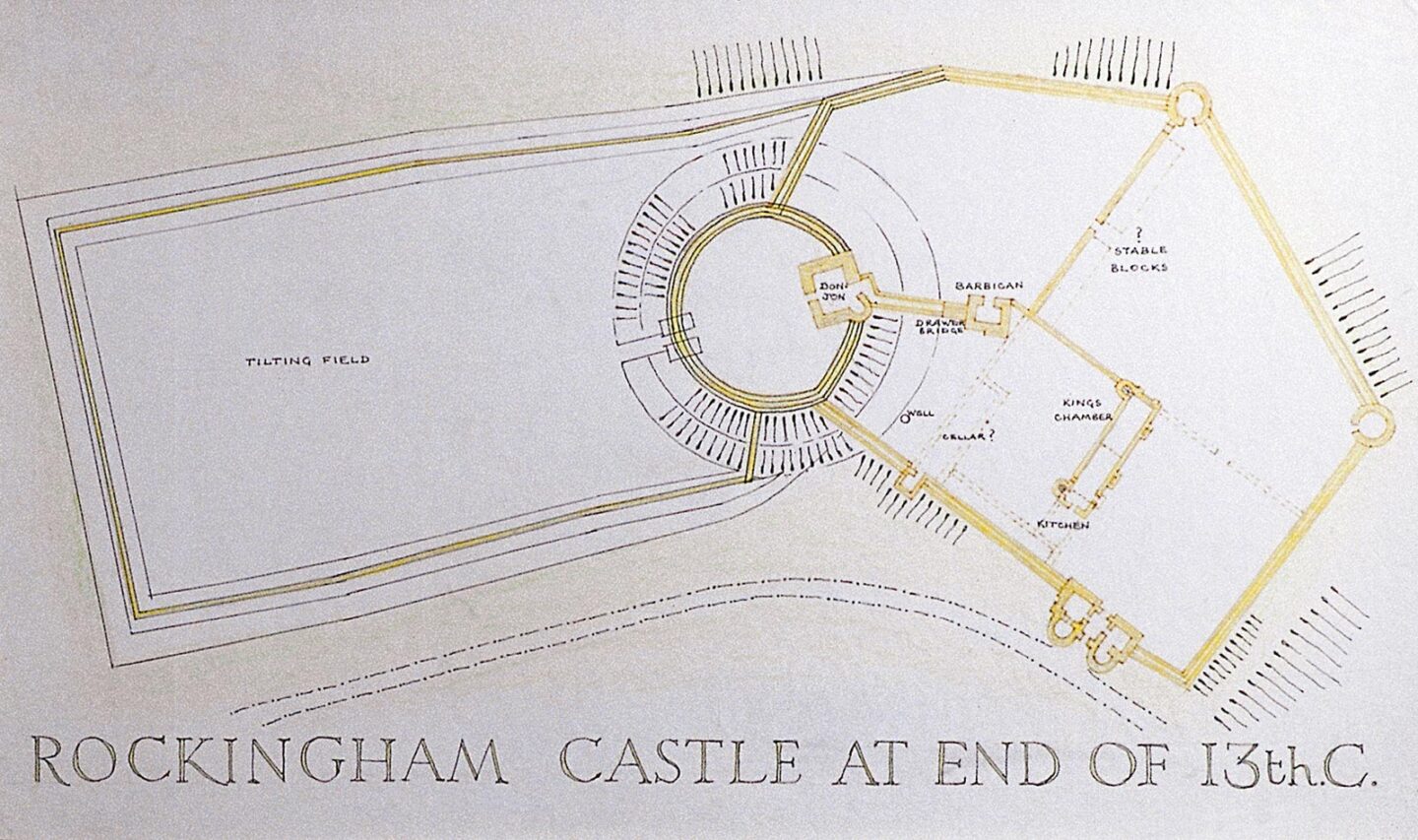
The original Norman motte and bailey, formed the core of the castle. The bailey with its curtain wall, and adjoining motte, enclosed 3½ acres; plus a second bailey (now the Tilting Lawn).
- The motte: Was 30’ high and 100’ wide surrounded by a 30’ wide moat; on it there was a well.
- The baileys. Rockingham had two baileys, like Windsor and Carisbrooke castles. The main bailey was north of the motte and contained the principal buildings [see below]. The bailey to the south of the motte, now called the Tilting Lawn, was the medieval tilt-lawn and military training area.
- Defences south of the Tilting lawn. Here there were further defences. The raised, tree-lined walks along its south-west side (lined with limes), and south-east side (lined with sycamores) – the SE one still showing a clear ditch and mound – seem to be the remains of part of the defences, perhaps remodelled in the C17.
- Water feature at South Lodge: A little way south of the Tilting Lawn, crossed by the drive from South Lodge, is a 300m long moat or canal. Its date and function is not known, but was presumably defensive and dates from the middle ages, since the feature was already present in 1615.
- The Keep Was a two-floored polygonal shell keep with a six-sided interior and an 80’ wide exterior which may have been circular or perhaps 18-sided. Within the keep the two storeys consisted of storerooms, and an entrance room on the ground floor, serving the 6 upper chambers which provided sleeping accommodation. This shell keep enclosed an open centre (like a ring doughnut), as at Windsor or Durham castles. (The present yew hedge and rose beds echo this structure.) There was a small chapel, ruinous in 1250, at ground level (probably on the motte but separate from the keep), Surrounding the keep was a mantelet wall. The Keep “was finally demolished perhaps as part of the slighting of the castle after the Civil War.” [Glenn Foard]
- A Barbican Tower This defended the drawbridge that led to the keep, and a second drawbridge led from the Barbican into the bailey.
- The Curtain Wall This surrounded the bailey, with mural towers at intervals.
- This largely survives on the east side, by the Street, but on the north and west it was restored, and embellished with stone balls, after the Civil War.
- At the two points where the curtain wall met the motte there were mural towers called flanker towers, with the 13C one at the end of the Street still surviving. The other was on or near the site of the bandstand, where the curtain wall met the motte. (The bandstand is a projecting stone bastion, built in the C19 (probably on one of the Civil War ‘Flankers’) to afford views over the gardens and to the Welland valley. The pergola on top was constructed in 1909.)
- On the east side the curtain wall stood on an 8’ high bank, and was 9’ thick (still visible in the Hammer Door opening).
- The north and west curtain walls were narrower than the east wall, because the steepness of the terrain did not require the thickness of the east wall.
- There was also in the bailey an interior dividing wall, the cross wall, running from the curtain wall to the motte (shown in the model in the Servants’ Hall). The site is now occupied by the Elephant Hedge (and perhaps gives its name to the Cross Garden?)
The Gatehouse
This was made of Weldon stone. Two strong semi-circular towers, with arrow slits, flank the entrance in the east wall, which was protected by a portcullis, with the grooves still visible. The pointed gateway arches have fine stone mouldings, with carved headstops, now very weathered, at the ends of the arches. The crenellation on the top of the towers was removed by Parliament after the Civil War, and recreated by Salvin in the mid-19C. He used the same Weldon stone as used in the 13C, so it blends in well.
The 1250 survey noted a gaol at Rockingham, probably in the Gatehouse. We know that prisoners captured in the siege of Lincoln in 1216, and prisoners captured at Dunbar in 1295 were housed, for 323 days, somewhere in the castle, but not necessarily in the Gatehouse – since they were high-class prisoners, including William son of John de Moravia, knight.
In 1354 a man called Robert Hod was imprisoned “for trespass of vert and venison in the forest of Rokyngham” [Pipe Rolls] – he probably was put in the Gatehouse!